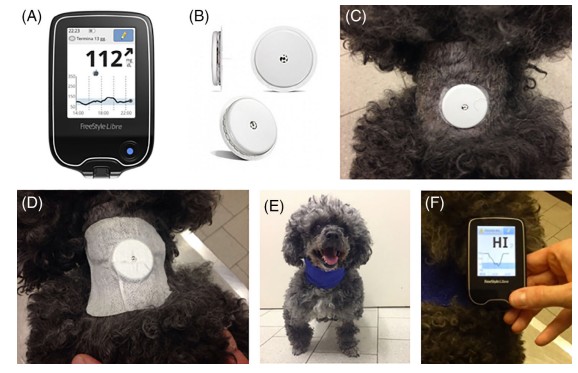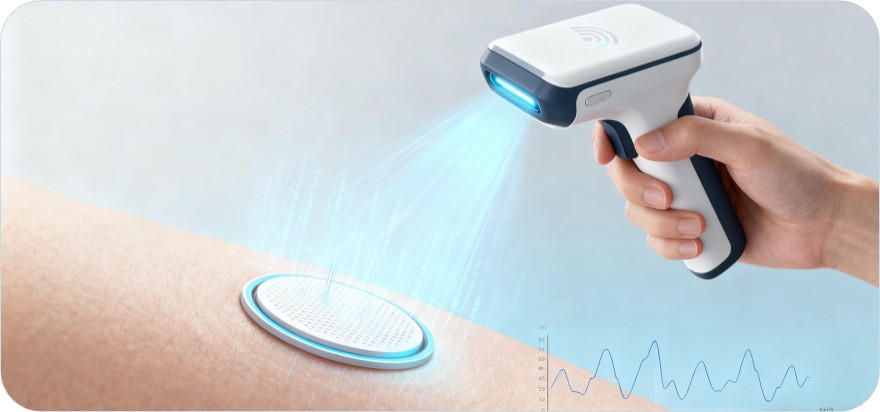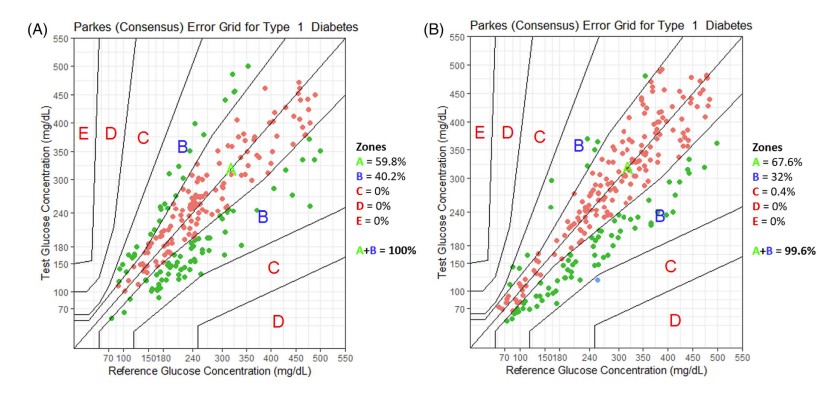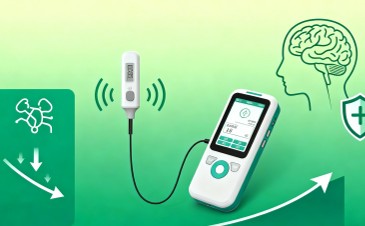Precision Assessment of a Flash Glucose Monitoring System in Canine Patients with Diabetic Ketoacidosis
Diabetic ketoacidosis (DKA) is a severe metabolic complication of diabetes mellitus in dogs, characterized by hyperglycemia, ketosis, and acidosis. This condition is life-threatening and requires immediate veterinary intervention. Traditional management of DKA involves frequent blood glucose monitoring using portable blood glucose meters (PBGMs), which necessitates multiple blood draws. This method is not only invasive but also stressful for the animals and can lead to complications such as iatrogenic anemia. The advent of Flash Glucose Monitoring Systems (FGMS) offers a promising alternative, providing continuous and non-invasive glucose monitoring.
 Fig.1 FreeStyle Libre is composed of the reader (A) and the sensor (B), which is placed on the dorsal part of the neck of the dog (C), secured by an additional tape (D) and a bandage applied around the neck (E). The sensor has to be scanned by the reader, which instantaneously shows the interstitial glucose value (F). The reader shows "HI" and "LO" when the interstitial glucose concentration is ≥500 mg/dL and ≤20 mg/dL, respectively. (Malerba E., et al., 2020)
Fig.1 FreeStyle Libre is composed of the reader (A) and the sensor (B), which is placed on the dorsal part of the neck of the dog (C), secured by an additional tape (D) and a bandage applied around the neck (E). The sensor has to be scanned by the reader, which instantaneously shows the interstitial glucose value (F). The reader shows "HI" and "LO" when the interstitial glucose concentration is ≥500 mg/dL and ≤20 mg/dL, respectively. (Malerba E., et al., 2020)
Traditional Glucose Monitoring Methods and Their Limitations
Portable Blood Glucose Meters (PBGMs)
PBGMs have long been the standard for monitoring blood glucose levels in dogs with DKA. These devices require frequent capillary or venous blood sampling, typically every 1-2 hours. While effective, this method has several drawbacks:
- Invasiveness: Repeated blood sampling can cause stress and discomfort to the animal.
- Risk of Anemia: Frequent blood draws can lead to iatrogenic anemia, particularly in small breed dogs.
- Intermittent Monitoring: PBGMs provide only intermittent glucose readings, which may miss rapid fluctuations in blood glucose levels.
- Increased Workload: The need for frequent sampling increases the workload for veterinary staff and can be costly due to the consumption of test strips.
The Evolution of Continuous Glucose Monitoring Systems

Continuous Glucose Monitoring Systems (CGMS)
The development of CGMS marked a significant advancement in glucose monitoring technology. These systems measure interstitial glucose levels continuously, providing a more comprehensive view of glucose trends. However, first-generation CGMS required frequent calibration with blood samples, limiting their practicality in clinical settings.

Flash Glucose Monitoring Systems (FGMS)
The introduction of FGMS, such as the FreeStyle Libre system, has revolutionized glucose monitoring. FGMS uses a small, factory-calibrated sensor that measures interstitial glucose levels continuously. The sensor is inserted subcutaneously and can be worn for up to 14 days without the need for recalibration. The system provides real-time glucose readings and historical data, allowing for better management of glucose levels.
Clinical Evaluation of FGMS in Dogs with DKA
- Study Design and Methodology
A recent study conducted by Malerba et al. (2020) evaluated the accuracy and clinical utility of the FGMS in dogs with DKA. The study included 14 client-owned dogs diagnosed with DKA, based on clinical signs, blood glucose concentration, blood β-hydroxybutyrate (BHB) concentration, and venous pH or bicarbonate levels. The dogs were treated with intravenous insulin infusion, and DKA was considered resolved when BHB levels and pH/bicarbonate levels returned to normal.
- Accuracy and Clinical Utility
The study found that the FGMS provided clinically accurate estimates of blood glucose levels in dogs with DKA. The correlation between interstitial glucose (IG) measurements and blood glucose (BG) levels was strong both before and after DKA resolution (r = 0.88 and r = 0.93, respectively). Although the FGMS did not meet the analytical accuracy requirements set by ISO 15197:2013, it demonstrated clinical accuracy with 100% and 99.6% of results falling within zones A and B of the Parkes consensus error grid analysis before and after DKA resolution, respectively.
 Fig.2 Parkes consensus error grid analysis (EGA) representation with the percentage of values within different zones before diabetic ketoacidosis (DKA) resolution (A) and after DKA resolution (B). (Malerba E., et al., 2020)
Fig.2 Parkes consensus error grid analysis (EGA) representation with the percentage of values within different zones before diabetic ketoacidosis (DKA) resolution (A) and after DKA resolution (B). (Malerba E., et al., 2020)
- Impact of Metabolic Variables
The study also evaluated the influence of metabolic variables (BHB, pH, bicarbonate, and lactate), body condition score (BCS), and sensor wear time on the accuracy of the FGMS. The results indicated that changes in these variables did not significantly affect the accuracy of the FGMS. This suggests that the device is reliable across a range of clinical conditions and can be used effectively in both stable diabetic dogs and those with DKA.
Clinical Implications and Future Directions
Enhanced Patient Management
The FGMS offers several advantages over traditional PBGMs, including continuous and non-invasive glucose monitoring. This technology can enhance the management of DKA, reducing the risk of complications such as hypoglycemia and cerebral edema. The real-time data provided by the FGMS allows for more informed treatment decisions, potentially improving patient outcomes.
Future Research
Future research should focus on expanding the sample size and evaluating the FGMS in different clinical settings to further validate its accuracy and reliability. Investigating the impact of sensor placement and tissue thickness on glucose readings could provide insights into optimizing the use of the FGMS in veterinary practice. Additionally, exploring the long-term effects of continuous glucose monitoring on the overall health and quality of life of diabetic dogs is an important area for future studies.
Conclusion
The introduction of the Flash Glucose Monitoring System represents a significant advancement in the management of diabetic ketoacidosis in dogs. By providing continuous, non-invasive glucose monitoring, the FGMS offers a more accurate and humane alternative to traditional methods. As veterinary medicine continues to embrace technological advancements, the FGMS stands out as a promising tool for improving the care and treatment of diabetic dogs. Further research and clinical trials will undoubtedly solidify its role in veterinary practice, paving the way for better outcomes and enhanced quality of life for our canine companions.
If you have related needs, please feel free to contact us for more information or product support.
Reference
- Malerba, Eleonora, et al. "Accuracy of a flash glucose monitoring system in dogs with diabetic ketoacidosis." Journal of veterinary internal medicine 34.1 (2020): 83-91.
These products and services are for research use only and cannot be used for any clinical purposes!



 Fig.1 FreeStyle Libre is composed of the reader (A) and the sensor (B), which is placed on the dorsal part of the neck of the dog (C), secured by an additional tape (D) and a bandage applied around the neck (E). The sensor has to be scanned by the reader, which instantaneously shows the interstitial glucose value (F). The reader shows "HI" and "LO" when the interstitial glucose concentration is ≥500 mg/dL and ≤20 mg/dL, respectively. (Malerba E., et al., 2020)
Fig.1 FreeStyle Libre is composed of the reader (A) and the sensor (B), which is placed on the dorsal part of the neck of the dog (C), secured by an additional tape (D) and a bandage applied around the neck (E). The sensor has to be scanned by the reader, which instantaneously shows the interstitial glucose value (F). The reader shows "HI" and "LO" when the interstitial glucose concentration is ≥500 mg/dL and ≤20 mg/dL, respectively. (Malerba E., et al., 2020) 

 Fig.2 Parkes consensus error grid analysis (EGA) representation with the percentage of values within different zones before diabetic ketoacidosis (DKA) resolution (A) and after DKA resolution (B). (Malerba E., et al., 2020)
Fig.2 Parkes consensus error grid analysis (EGA) representation with the percentage of values within different zones before diabetic ketoacidosis (DKA) resolution (A) and after DKA resolution (B). (Malerba E., et al., 2020)
